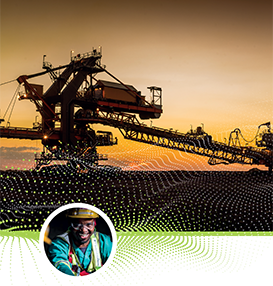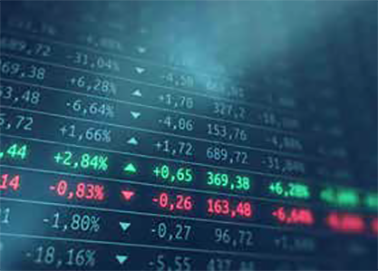Integrated report 2019

Exxaro’s macro-economic operating context and commodity markets include global and local influences that affect our ability to create value over time for all of our stakeholders.
In determining our material matters over the past year, we grouped matters of significance in this regard under the theme macro-environment.
![]() Financial
Financial
![]() Manufactured
Manufactured
![]() Social and relationship
Social and relationship
![]() Natural
Natural
![]() Human
Human
| Trend | Cause | Effect | Our response | |||
Slowdown in global economic growth
|
Escalating US-China trade tension, with stagnation in global manufacturing activity, contributed to the world’s real GDP growth rate declining to 2.6% (2018: 3.2%). Growth in global steel production, particularly in China, decelerated. Iron ore prices were steady although highest in the first half of the year. The price of Brent crude oil remained range-bound towards the end of the second half of 2019 after temporarily elevated levels due to the attack on Saudi Arabian oil facilities. |
Demand for sized product in the domestic market was positive. As more domestic supply was available due to weak export prices, domestic pricing remained stable. The seaborne thermal coal market remained in an oversupplied position with export sales prices dropping by 27% after trading at US$98/tonne on average in 2018. The soft ban on coal imports in China and a sluggish Indian economy exerted pressure on seaborne trades. European stock levels remained relatively high due to cheap gas prices. India continues to draw South African coal. + For more information, see coal production and sales volumes in our Operational performance |
We remain committed to monetising our remaining stake in Tronox Holdings plc with prevailing market conditions in mind. Our interests in Black Mountain and the Chifeng Kumba Hongye Corporation’s refinery remain non-core while we work on divestment plans for Black Mountain. The divestment in Arnot has been concluded. The outstanding condition was the cession of the current coal supply agreement between Eskom and Arnot OpCo. Competition Commission and section 11 approvals had already been obtained. The potential development plan for the Moranbah South coking coal project is being reassessed by Exxaro and Anglo American. + For more information, see coal production and sales volumes in our Operational performance |
|||
Evolving societal and regulatory environment
|
Globally, mining companies are facing increasing demands from diverse stakeholder groups, and maintaining a social licence to operate remains a top risk. Furthermore, across all stakeholder groups, there is, rightly so, increasing intolerance of poor business and sustainability practices. Shareholder activists are also placing increasing pressure on companies, particularly coal miners, to give voice to their long-term ambitions within this context. |
A breakdown in trust can bring a mine to its knees faster than any other risk. Focus on building relationships of mutual benefit with communities should therefore be a top priority for all mines. Furthermore, in the context of greater water stress and extreme weather events due to global warming, coal producers are facing more intense pressure to reassess their portfolios and demonstrate how they are contributing to the transition to a low-carbon economy. + For more information, see energy transition below |
We are ever mindful that the transition to a low-carbon future should improve lives as we aspire to promote a cleaner way of living. Our purpose remains a critical responsibility: to power better lives in Africa and beyond, complemented by a new vision: to see resources powering a clean world. + For more information, see our CEO’s report and strategy |
|||
Energy transition
|
We have observed intensified global action on climate change and a move to restrict the use of fossil fuel for energy generation. The findings of the Intergovernmental Panel on Climate Change (IPCC), in its special report on the impacts of global warming of 1.50C, paints a grim picture of the consequences of the current trajectory in greenhouse gas emissions and changing climate patterns. |
Under the current trajectory, we expect the transitional and physical risks of climate change on our business will be medium to high over the next 20 to 30 years. + For more information, see risks and opportunities |
Our response has been to ensure a sustainable Exxaro in a carbon-constrained environment. On 4 June 2019, the board passed a unanimous resolution to reassess the group’s climate-change risks and opportunities in line with the recommendations of the FSB's TCFD. An internal multifunctional task team is developing a strategy using the TCFD recommendations. Progress and results will be presented to the market when the review process has concluded. + For more information, see climate change |
|||
Big data and mining
|
Digital and technological innovation has opened avenues to improve productivity, safety and environmental management in the mining industry. |
Companies are exploring new data-informed methods of mining, assisted by technology, which requires an understanding of the potential future workforce and new skills sets. + For more information, see innovation and information management |
The Exxaro digitalisation and innovation journey is a strategic initiative driven by the CEO. Our award-winning Digital@ Exxaro programme is transforming our company culture to ensure that we are more open and agile when we engage with stakeholders internally and externally. + For more information, see Digital@Exxaro |
During 2019, escalating US-China trade tensions and Brexit uncertainty were reflected in the global economic slowdown and hence market sentiment and performance.
| Global GDP +2.6% (2018: 3.2%) |
 |
API4 coal export price averaged US$72 per tonne (2018: US$98/t) expected to soften in 2020 |
| ⮞ | Global economic slowdown |
| ⮞ | US-China trade tensions |
| ⮞ | Manufacturing stagnation |
| ⮞ | South African growth below potential |
US-China trade tension in 2019 resulted in higher cost to businesses and consumers, lower product demand, disrupted and less efficient supply chains, financial market volatility, reduced international trade and investment flows, and diminished competition and innovation.
Global manufacturing activity stagnated with several countries’ manufacturing purchasing managers’ index (PMI) contracting for extended periods during the year.
World real GDP growth in 2019 declined to 2.6% compared to 3.2% in 2018. A global economic recession is anticipated in 2020, mainly as a result of the impact of the global spread of the coronavirus (COVID-19) pandemic.
| Real GDP growth rate (%) | |||
| 2020 forecast |
2019 | 2018 | |
| World | (2.8) | 2.6 | 3.2 |
| US | (5.4) | 2.3 | 2.9 |
| Eurozone | (4.5) | 1.2 | 1.9 |
| China | 2.0 | 6.2 | 6.6 |
| India | 2.1 | 4.8 | 6.8 |
| South Africa | (3.0) | 0.2 | 0.8 |
South Africa’s economic growth in 2019 was again disappointing and remained well below potential. However, some positive signs were evident in the implementation of key economic reforms although the challenging and tough decisions will take time to implement. The upside is that there is potential for an investment rebound in future.
|
IMPLICATIONS FOR EXXARO 
STRATEGIC RESPONSE |
IMPLICATIONS FOR EXXARO 
STRATEGIC RESPONSE |
| ⮞ | Persistently low inflation |
| ⮞ | Less stringent monetary policy |
During 2019, in response to a deteriorating global growth outlook, a significant number of central banks turned to monetary easing to support economies. In many cases, interest rate cuts were facilitated by subdued inflation while some countries battled economic crises and others suffered apparent political interference in monetary policy decisions. South Africa’s consumer price index (CPI) was 4.1%, which was higher than the midpoint of the Reserve Bank policy of between 3% and 6%. It is expected to edge up slightly in 2020, barring any major shocks to the rand and fuel prices.
IMPLICATIONS FOR EXXARO 
STRATEGIC RESPONSE |
 |
Iron ore Fines US$94 per dry metric tonne (CFR) China (2018: US$70/dmt) |
Political and policy Cautious optimism |
| ⮞ | Chinese renminbi (CNY) |
| ⮞ | US dollar (US$) |
The Chinese currency fell past the market-presumed red line of 7CNY/US$ in 2019 before it recovered somewhat, mainly due to market pressure induced by punitive US tariffs on Chinese goods and general US dollar strength. Safe haven status also supported the US dollar in times of tension.
In South Africa, currency volatility continued throughout the year with weak economic growth, political distractions and negative emerging market sentiment as the key drivers. However, the continued search for yield by investors, among others, supported the rand at times of risk-on sentiment. Rand volatility is expected to continue into 2020.
IMPLICATIONS FOR EXXARO 
STRATEGIC RESPONSE |
| ⮞ | Cautious optimism |
The reality of South Africa’s economic growth challenges, with much-needed economic reforms, was again highlighted in the draft growth policy document released by National Treasury. Optimism prevailed that focus would shift to implementation of critical economic reforms to enable a sustainable economic growth path for the country.
IMPLICATIONS FOR EXXARO 
STRATEGIC RESPONSE |
| ⮞ | Domestic supply and demand up |
| ⮞ | Seaborne thermal coal oversupplied |
Favourable demand for sized product in the domestic market continued in 2019. As domestic supply increased due to weak export prices, domestic pricing remained stable.
The seaborne thermal coal market remained in an oversupplied position. Export sale prices dropped by 27% in 2019, having traded at US$98/t on average in 2018. The soft ban on coal imports in China and a sluggish Indian economy exerted pressure on seaborne trades.
European stock levels remained relatively high as a result of cheap gas prices while India continued to draw South African coal.
IMPLICATIONS FOR EXXARO 
STRATEGIC RESPONSE |
| ⮞ | Mixed performance |
| ⮞ | Key drivers |
Exxaro’s specific commodity markets recorded mixed performances in 2019. Slowing global economic growth, supply disruptions, escalating US-China trade tensions and energy transition themes were the key drivers in commodity markets during the year.
| Commodity prices (US$/t) | |||
| Commodity | 2020 forecast |
2019 | 2018 |
| Thermal coal (RB1) | 60.00 | 71.56 | 98.05 |
| Thermal coal (RB3) | 48.00 | 55.76 | 78.10 |
| Hard coking coal (prime) | 163.00 | 175.08 | 207.58 |
| Iron ore fines | 80.00 | 93.63 | 69.70 |
| Lump premium | 11.40 | 17.20 | 15.62 |
| Titanium dioxide pigment | 2 459 | 2 480 | 2 850 |
| Chloride slag | 835 | 777 | 682 |
| Zircon | 1 370 | 1 510 | 1 460 |
IMPLICATIONS FOR EXXARO 
STRATEGIC RESPONSE |
| ⮞ | Weak power generation in Asia’s manufacturing economies |
| ⮞ | LNG surplus |
| ⮞ | Low European gas prices |
| ⮞ | High global coal inventories (thermal) |
| ⮞ | Indian demand |
| ⮞ | Import restriction (metallurgical) |
During 2019, the global seaborne thermal coal market was under severe pressure from increasing domestic supply in China coupled with policy uncertainty, a global LNG surplus market, sustained low gas prices supported by high carbon prices in Europe leading to coal-to-gas switching, coupled with high renewables, hydropower and nuclear power generation, high global stockpiles at ports and weak seasonal demand in key Asian markets.
It was the year that LNG played a leading role. Significant oversupply of gas from the first quarter of 2019 and LNG storage overhang added to coal destocking pressure in Europe. The same LNG supply wave is expected to continue into 2020 as well as a similar thermal coal price pattern. Demand during the northern hemisphere winter supported title transfer facility (TTF) hub prices, which allowed some breathing space for coal.
Hard coking coal prices slumped to a two-year low in 2019 as Chinese port restrictions and weak Indian demand weighed heavily on the seaborne market. The unprecedented slump in the Indian automotive sector continued for most of 2019 as Indian buyers appeared to be in no hurry to restock. Construction activity in India also remained weak due to a sluggish macro environment. Barring any significant supply disruptions, a loose demand-supply balance is expected in 2020.
IMPLICATIONS FOR EXXARO 
STRATEGIC RESPONSE |
| ⮞ | High-level engagements |
Export rail performance from Grootegeluk declined after the annual coal line shutdown, exacerbated by a collision between two trains at the Matlabas crossing between Thabazimbi and Lephalale in October 2019.
The Transnet Freight Rail (TFR) Waterberg corridor expansion project slipped although it remained aligned with Grootegeluk’s export production ramp-up schedule.
From January to October 2019, export rail performance, in terms of our Mpumalanga and Waterberg Transnet long-term rail agreements, achieved 95% against the annual contracted tonnage.
Grootegeluk achieved an average of 4.7 trains per week in 2019.
High-level engagements are ongoing and train planning has been approved at levels above five trains per week.
IMPLICATIONS FOR EXXARO 
STRATEGIC RESPONSE |
| ⮞ | Robust Chinese steel output |
| ⮞ | Steel margins |
The iron ore price was a leading performer in 2019. The year began with Vale suffering tragedy when its tailings dam collapsed and some operations were suspended. Iron ore prices responded immediately as the market feared shortages while iron ore producers found it difficult to raise production to offset the loss. In addition, weather-related disruptions in northern Brazil and western Australia further tightened the market. Chinese steel production was stable during the year.
Within the iron ore market, the premium for higher-grade ore versus benchmark evaporated in 2019. Declining steel margins, and expectation of weaker steel demand amid ongoing growth in steel output, led steel mills to move back towards lower-grade fines. In addition, increased output of higher-grade ores was recorded with significant softening of the high-grade market. Improving exports and narrowing steel mill margins will be a drag on iron-ore prices into 2020.
IMPLICATIONS FOR EXXARO 
STRATEGIC RESPONSE |
| ⮞ | Subdued feedstocks and pigment markets |
The year was challenging for titanium dioxide (TiO2) feedstock and pigment markets. Weak TiO2 pigment demand in the US, China and Europe, due to a sluggish global automotive sector, US-China trade tension, concerns about Brexit and reduced consumer confidence, led to a decline in global TiO2 pigment production.
Deteriorating market sentiment and cost pressures in the market for zircon led to a general shift from premium towards standard-grade zircon, particularly in the ceramics sector of China hence an increase in premium-grade inventory levels in 2019.
Demand is expected to increase in 2020, led by the pigment sector, with capacity expansions and higher production in China, as well as a return to normal utilisation rates in North America.

Belfast Coal promised to deliver early run of mine (RoM) before the targeted date in October 2019 and did so on 14 March 2019 – seven months ahead of schedule.
The mining team worked in a timely and diligent manner to realise the revised business case to achieve the early RoM targets.
The operation is potentially the last sizeable value-adding greenfield coal project that Exxaro operates in Mpumalanga. It aims to support Exxaro’s strategic vision to increase steam coal exports and the company’s share of the South African coal market.
“Our strategy at Belfast Coal is to be a leading pioneer, unearthing the latest business trends and thereby increasing productivity and safety,” says Lazarus Ramashilabele, business unit manager. “The target is to double our output by 2023, which will contribute significantly to the Exxaro 2026 business strategy.”
Belfast is the first of its kind in South Africa to have a “digital twin” — a complete digital replica of the mine, which allows management to connect to and manage the operation from remote locations. The maintenance teams are thus able to analyse machinery and detect potential problems to improve safety and reduce downtime.
Exxaro began the R3.3 billion Belfast implementation project in July 2018 after more than 20 years of research and development.
The mine ranks as the last good-quality A-grade, high-yield coal deposit in Mpumalanga with an estimated lifespan of 12 years in its first phase operation.